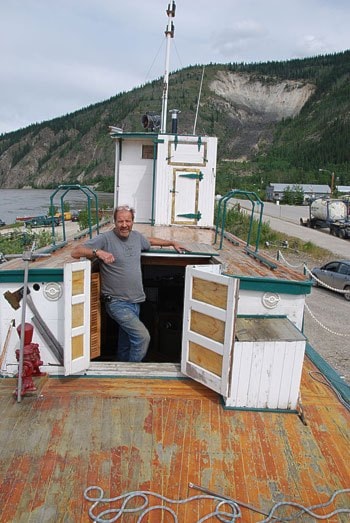The Yukon Rose has had a history of going to the bottom, but she has never stayed there for long.
In fact, current owner Marc Johnston has put her on the bottom several times himself - but he had good reasons for doing it.
The Dawson resident is working on two heritage vessels, the other being the Loon, which is currently dry-docked near Mayo, and both of them are going to spend time on the bottom.
I had a chance to visit Johnston in his most familiar environs during my recent trip to Dawson City - hunkered down next to the hull of this historic vessel, which is perched atop the dike not far from the ferry landing. Johnston was quick to show me the caulking that he was applying in place of the traditional oakum.
The Yukon Rose was originally commissioned by Taylor and Drury (T&D) in 1927, around the time that their previous vessel, the Thistle, sank in Lake Laberge. Built in Vancouver, she was designed with a tunnel drive propulsion system.
Simply stated, a tunnel drive is a recessed space on the underside of the boat that receives the drive shaft and propeller. Because it is positioned in a tapered cavity on the bottom of the Rose, the propeller is less likely to be damaged by catching on the river bottom.
Marc told me that this design improvement was successful, so a series of shallow draft boats was constructed with the same feature to navigate the various Yukon waterways. It is the precursor to the jet drive on modern boats.
The Yukon Rose embarked on her maiden voyage in July of 1929. She was stranded in the shallows of the Teslin River in the fall of 1929, laden with supplies destined for the Taylor and Drury store in Teslin. According to Johnston, she sank again in the shallow water of Ice Chest Rapids, on the Stewart River, in September of 1936.
She was chartered by the White Pass and Yukon Route at the time to pick up a barge load of ore.
According to the Mayo Miner, said Johnston, her rudders caught on the bottom and the stern had been “stove in.” She may have sunk many times, but she was always refloated.
The Yukon Rose continued in service to T&D for a dozen years, often being chartered to others during that time. She was taken out of service sometime around 1938 or 1939 and was mothballed in Whitehorse, until she was chartered by two Whitehorse men, who, in turn, leased her to the United States military after America declared war against the Japanese in 1941.
During the war, Marc told me, the Rose saw service in many parts of the territory, including Kluane, Bennett, Tagish and Teslin Lakes. She was in Dawson City in 1942 and eventually found her way to Fairbanks, Alaska, where she was beached for four years.
She was later bought by the White Pass and Yukon Route during a period of downsizing, taken to Dawson, and refitted with additional crew cabins on the upper deck so that she could hold more freight below deck. Still pushing a barge, she plied the waters between Dawson, the Stewart River, and the Pelly.
In 1955, Marc told me that she was sold again, to a private owner, and then again in the mid-1960s to a man who ran her aground on the Yukon River somewhere near Fort Selkirk and left her for the winter. Rudy Burian then bought it and operated it from Stewart Island until he sold it to Greg Caple of Dawson in 1978.
After the Dawson flood of 1979, the Yukon Rose was set up on cribbing in the back yard of
Caple’s house on Third Avenue. It passed through more hands until Johnston purchased it in 2000.
This is where things got technical. Johnston had to replace the rotted and fractured timbers. All the ribs were broken under the stringers on the starboard side and had to be replaced. He lifted the cabin and deck to allow full access to the hull.
Often working in temperatures down to -30 C, he steamed oak planks in a steam chamber, and then while they were pliable, he formed them to the shape of the hull.
He replaced 150 ribs in this fashion, installing eight on his best day.
The original Vivian engine had long been replaced by White Pass. When Johnston acquired the boat, he purchased a replacement engine in Florida, drove there to pick it up, then returned with it to Dawson City. He installed it early on in the reconstruction of the Rose, but it will not be attached to the drive shaft or firmly mounted in place, until it is back in the water and has assumed the conformation it will have when it is put into operation.
Johnston plans to have the engine running by the end of this year, and the Yukon Rose operational by 2014. Of course, it will have to be put back in the water so that the dried planking can reach equilibrium moisture content compatible with river travel.
Meanwhile, in Mayo, he has been working on the Loon for several years, using personnel supplied by the First Nation of Nacho Nyak Dun. It was built in 1923 and operated by the White Pass and Yukon Route. Johnston plans to have it operational by 2013. But first, he has to build a pond and settle it on the bottom so that the hull planking can be acclimatized to the wet conditions she will be working in. We can expect to see it plying the waters of the Stewart River in the very near future.
Michael Gates is a Yukon historian and sometimes adventurer based in Whitehorse. His new book, Dalton’s Gold Rush Trail, is now available in stores. You can contact him at msgates@northwestel.net
